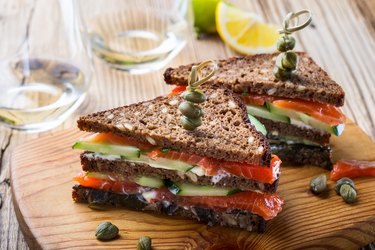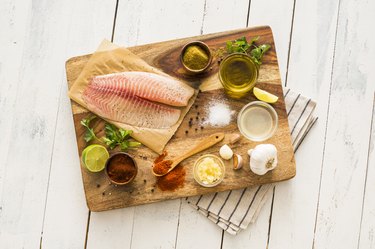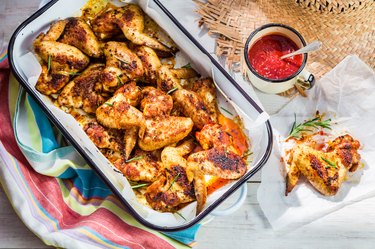Should you cover turkey with foil while it cooks? Well, putting aluminum foil over turkey can help the cooking process as it roasts.
There are two ways to do it: Enclose the turkey in the foil before roasting it in a hot oven or use the foil as a tent to control the level of browning.
Covering the whole turkey with foil is a popular cooking method because it steams the turkey in its own juices, per the University of Illinois Extension. If done correctly, the end result is a wonderfully moist bird with golden brown, non-crispy skin.
When deciding whether to cover your turkey with foil or not, consider that enclosing it makes it cook faster. The compromise here is that the turkey skin, while golden, wont come out crispy.
If youre looking for a crispier result, you should tent your turkey with aluminum foil. The tent method yields perfectly brown, crispy skin and a slow-roasted flavor, but it does takes more time.
It is not recommended to stuff your turkey before cooking it, especially if it is enclosed in a small space, per the USDA. So, if you are fully enclosing your bird in foil, or you are grilling, microwaving or deep-frying, it dont stuff your turkey.
The faster cooking times dont allow the stuffing to heat quickly enough to kill food-borne bacteria in the stuffing. If you are tenting the turkey, you can stuff it, per the University of Illinois Extension.
Roasting turkey can be tricky business. It’s easy to end up with bone-dry breast meat or undercooked dark meat. That’s where tenting the turkey with aluminum foil comes in handy. Tenting with foil allows you to get perfectly cooked turkey with browned, crisp skin every time.
What is Tenting a Turkey?
Tenting a turkey involves draping aluminum foil loosely over the roasting bird in a tent-like fashion. The foil traps in heat and moisture to ensure the turkey cooks evenly. Unlike fully wrapping the turkey in foil, tenting leaves openings so the turkey still browns and crisps up.
Tenting is an easy technique that pays off with juicy, golden turkey without any fuss. Once you learn how, you’ll never roast turkey uncovered again!
Benefits of Tenting Turkey with Foil
There are several advantages to tenting turkey with foil while it roasts
- Prevents breast meat from overcooking and drying out
- Allows thighs and legs to cook through fully
- Promotes even cooking throughout
- Skin gets beautifully browned and crisp
- Locks in moisture so meat stays tender
- Lets you baste without uncovering turkey
Overall, tenting helps you get the best of both worlds – browned exterior and super juicy interior.
How to Make a Foil Tent for Turkey
Follow these simple steps for perfectly tenting your turkey every time:
1. Prepare Turkey and Pan
Remove giblets from the cavity Rinse turkey inside and out with cold water Pat very dry with paper towels.
Place turkey breast side up on a roasting rack in a pan. Brush all over with oil or melted butter. Season generously with salt and pepper.
2. Preheat Oven
Preheat oven to 350°F
3. Make Foil Tent
Tear off a piece of heavy duty foil about 2 feet longer than the turkey. Fold foil in half lengthwise to make a long, narrow sheet.
Place foil over breast of turkey, crimping foil against the pan on both sides to secure it.
Lift foil above breast about 1-2 inches to allow airflow. Foil should slope up from pan edges and loosely drape over turkey.
4. Roast Turkey
Roast turkey, basting occasionally if desired by lifting foil. Use a meat thermometer to check temperature.
When breast hits 160°F, tent should be golden brown. Remove foil and roast until 165°F for breast, 175°F for thighs.
5. Let Turkey Rest
Remove turkey from oven, tent loosely with new foil and let rest 20 minutes before carving.
Turkey Tenting Tips
-
For better browning, start turkey uncovered for about 1 hour. Then add foil tent.
-
Use heavy duty or extra thick foil so tent doesn’t tear while lifting to baste.
-
Make tent edges higher above breast if it seems to be browning too fast.
-
Add tent when breast temp reaches 120°F to prevent overcooking.
-
Don’t let foil touch skin directly or it may stick. Tent higher if needed.
-
Check pan juices occasionally to prevent burning since foil traps drippings.
-
If breast or thighs brown too fast, cover them with a small piece of foil.
-
Avoid peeking under tent often or it will increase cook time. Lift just to baste.
Get Perfectly Roasted Turkey Every Time
Tenting your turkey with foil is a no-fuss way to get moist, tender meat and crisp, golden skin on your holiday bird. The foil seals in juices while allowing air circulation for browning. Follow the simple steps above for foolproof roasted turkey. Pair your roasted masterpiece with favorite Thanksgiving side dishes like stuffing, mashed potatoes, and cranberry sauce for a mouthwatering feast.

Foil Tent Turkey Cooking Instructions
- Preheat the oven to 325 degrees Fahrenheit.
- Place the turkey in the roasting pan breast-side up.
- Brush the turkey with melted butter or olive oil.
- How to tent with foil? Make a tent-shape with the foil by creasing a piece of foil in the center. Prop it up over the turkey. The ends will be in the roasting pan. Stand the center up 1 inch over the turkey breast to allow for air flow.
- Put the turkey in the oven. Roast it until a thermometer inserted in the innermost part of the thigh and wing and the thickest part of the breast reaches 165 degrees Fahrenheit, per the University of Illinois Extension. Let the turkey stand for 20 minutes, as recommended by the USDA Food Safety and Inspection Service, to improve ease of carving.
How to Cook a Turkey With Aluminum Foil
To cover or not to cover a turkey? If you have a limited amount of time to roast your bird, you can cover turkey in aluminum foil beforehand, which will shorten the cooking time. Just make sure you dont seal the foil so its airtight, or moisture will be trapped inside and affect the end result.



- Preheat the oven to 450 degrees Fahrenheit, according to the University of Illinois Extension.
- Tear off a piece of 18-inch-wide, heavy-duty aluminum foil that is three times longer than the length of the turkey. Lay it over a large roasting pan, centered lengthwise.
- Place the turkey on the aluminum foil breast-side up. Brush the turkey with melted butter or vegetable oil.
- Bring the sides of the aluminum foil up along the sides of the turkey. Bring the ends of the foil up over the top of the turkey. Overlap the ends of the foil so they will stay in place, but dont seal them so they are airtight.
- Put the turkey in the oven. Roast the turkey until a meat thermometer inserted into the thickest part of the thigh reads a minimum of 165 Fahrenheit, according to the University of Illinois Extension.
The cooking time for a turkey wrapped in foil will vary based on the weight of your bird. An 8- to 12-pound turkey will need 2.75 to 3 hours to cook through at 325 F, according to the USDA Food Safety and Inspection Service. Roasting at a higher temperature lowers this cooking time.
At What Temperature Should You Cook Your Turkey?
Your oven temperature should be set at no lower than 325 F, according to the USDA. A higher temperature will speed up the cooking time.
When it comes to foil-wrapped turkey, you can set your oven at a higher temperature — the University of Illinois Extension suggests 450 F.
A whole turkey is safe to eat when its internal temperature is a minimum of 165 F, which can be measured with a food thermometer.
How to Tent a Turkey with Reynolds Wrap® Heavy Duty Aluminum Foil
FAQ
Should I cover the turkey with aluminum foil?
How do you tent meat with aluminum foil?
